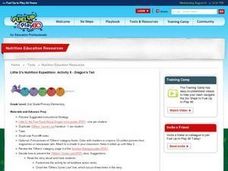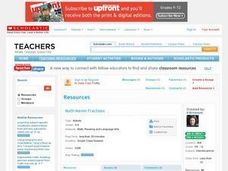Curated OER
Dinosaur Designs
Second graders examine facts that can be found in nonfiction books. They listen to a read aloud of Patrick's Dinosaur, with time before the end for student predictions. They make dinosaur t-shirts using facts from the book.
Curated OER
Sentences And Sequencing
Students practice writing complete sentences and sequencing three or more events. They listen to at least one version of the story read aloud and work cooperatively to put the story events in proper sequence. They access a...
Curated OER
The Farmer's Sheep
Students use problem solving skills, logical thinking, and their ability to work sequentially in order to solve an algebra problem. They listen to the problem read aloud by the teacher and devise a plan in order to solve the problem.
Curated OER
Foreign Language Initial Reading
Students match sentences and phrases to pictures in a target language. They identify the proper written form of familiar spoken phrases. Students practice labeling objects and pictures with the proper greeting, color, number or object...
Curated OER
Nonfiction Genre Mini-Unit: Persuasive Writing
Should primary graders have their own computers? Should animals be kept in captivity? Young writers learn how to develop and support a claim in this short unit on persuasive writing.
Houghton Mifflin Harcourt
We Can Work It Out: English Language Development Lessons (Theme 7)
Listen, look, speak, and move are the routine steps of the English language development lessons found in a We Can Work It Out themed unit. Language proficiency is reinforced through picture cards, poems, and grand discussions about...
Curated OER
The Red Badge of Courage: Vocabulary Bingo!
To reinforce recognition of vocabulary words drawn from Stephen Crane's The Red Badge of Courage, readers engage in a vocabulary bingo game.
Curated OER
The Seven Continents Scavenger Hunt
Who doesn't enjoy an engaging scavenger hunt? Here, scholars listen to, and discuss, the informative text, Where is my Continent? by Robin Nelson. They then explore the seven continents and four major oceans using Google Earth.
Plum Tree
Teaching Your Child How to "Deep Breathe"
Feeling stressed, angry, or nervous? It's time to practice the exercise detailed in Deep Breathe to breathe your cares away. The activity brings the focus back to one's self and identifies the importance of staying calm.
EngageNY
Word Problems Leading to Rational Equations
Show learners how to apply rational equations to the real world. Learners solve problems such as those involving averages and dilution. They write equations to model the situation and then solve them to answer the question — great...
Channel Islands Film
Arlington Springs Man: Lesson Plan 1
Learning to craft quality questions is a skill that can be taught. Class members use the Question Formulation Technique to learn how to create and refine both closed-ended and open-ended questions. They then view West of the West's...
Curated OER
Opening a Special Ed Class
This is not just a lesson plan, it's a life saver! Here are 10 separate documents intended to assist a new Special Ed teacher. There are 4 different games, instructional tips, ways to handle documentation, behavioral modification...
Curated OER
The Dragon's Tail
Second graders read a story about Little D, a baby dragon, and how he interacts with the five food groups. They color, chant, pantomime, and discuss food groups after reading the story. They also consider causes and effects as they make...
Curated OER
Math Maven Fractions
Students solve fraction mysteries. In this fractions instructional activity, students read Math Maven's Mysteries and use problem-solving and critical thinking skills to solve the mysteries.
Curated OER
Readers Theatre: The Three Snow Bears
Students dramatize the story, Three Snow Bears by Jan Brett. In this readers theatre instructional activity, students read the story and then dramatize the events during readers theatre. There is an included script.
Orange County Department of Education
Black Cowboy, Wild Horses
Fifth graders read the selection Black Cowboy, Wild Horses and identify characteristics of self-discipline shown by story's main character, Bob Lemmons. Students then identify some of their own traits of self-discipline and reflect upon...
Curated OER
Cancer Research
Students participate in a class demonstration to see how many Americans are affected by cancer in their lifetime. In this public health lesson, students are placed in situations that allow them to experience how relevant cancer research...
Curated OER
Cashing In on Cartoons
Students examine the popularity of cartoon characters in marketing strategies. They work on developing their own cartoon characters that could be used for a licensing plan.
Curated OER
Play Ball
Students study the history of baseball in Brooklyn. They read a shared reading about the history of baseball in Brooklyn and respond to an archival picture of an early baseball game. They write two "teacher questions" for the class to...
Curated OER
Youth Helping to Elevate Awareness
Eighth graders read a book whose main character has a physical disability, and complete various related activities. They listen to a guest speaker, simulate experiences at school as a disabled individual through the use of wheelchairs,...
Curated OER
Freckle Juice
Students complete activities with the book Freckle Juice by Judy Blume. In this literature lesson, students read chapter one and brainstorm adjectives for the four main characters. They make a page of vocabulary words and definitions.
Curated OER
Poetry and Visualization
Students use visualization techniques when reading poetry. In this visualization and poetry lesson, students work in groups to present a tableau that depicts a word from the poem as classmates guess the word. Students then read the...
Curated OER
Planets in Proportion
Students apply estimation strategies and proportional reasoning to determine a scale comparing the planetary bodies to Earth. They convert measurements of time and distance using scientific notation. Both the metric and customary units...
Curated OER
Problem Solving Process: One-To-One Correspondence
First graders observe and demonstrate a variety of problem solving strategies to solve problems involving one-to-one correspondence and whole numbers to 100. They discuss the steps of the problem solving process, and solve a word...

























